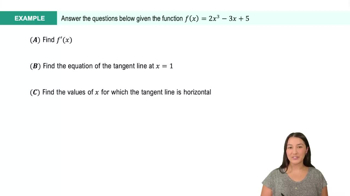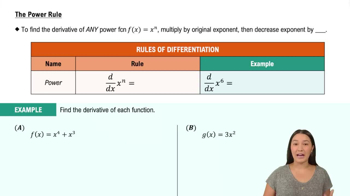Table of contents
- 0. Functions7h 52m
- Introduction to Functions16m
- Piecewise Functions10m
- Properties of Functions9m
- Common Functions1h 8m
- Transformations5m
- Combining Functions27m
- Exponent rules32m
- Exponential Functions28m
- Logarithmic Functions24m
- Properties of Logarithms34m
- Exponential & Logarithmic Equations35m
- Introduction to Trigonometric Functions38m
- Graphs of Trigonometric Functions44m
- Trigonometric Identities47m
- Inverse Trigonometric Functions48m
- 1. Limits and Continuity2h 2m
- 2. Intro to Derivatives1h 33m
- 3. Techniques of Differentiation3h 18m
- 4. Applications of Derivatives2h 38m
- 5. Graphical Applications of Derivatives6h 2m
- 6. Derivatives of Inverse, Exponential, & Logarithmic Functions2h 37m
- 7. Antiderivatives & Indefinite Integrals1h 26m
- 8. Definite Integrals4h 44m
- 9. Graphical Applications of Integrals2h 27m
- 10. Physics Applications of Integrals 2h 22m
3. Techniques of Differentiation
Basic Rules of Differentiation
Problem 114b
Textbook Question
Derivatives of even and odd functions Recall that f is even if f(−x) = f(x), for all x in the domain of f, and f is odd if f(−x) = −f(x) for all x in the domain of f.
b. If f is a differentiable, odd function on its domain, determine whether f' is even, odd, or neither.
 Verified step by step guidance
Verified step by step guidance1
Step 1: Recall the definition of an odd function. A function f is odd if f(-x) = -f(x) for all x in its domain.
Step 2: Consider the derivative of f, denoted as f'. We want to determine the nature of f' (even, odd, or neither).
Step 3: Use the definition of the derivative: f'(x) = \lim_{h \to 0} \frac{f(x+h) - f(x)}{h}.
Step 4: Substitute -x into the derivative definition: f'(-x) = \lim_{h \to 0} \frac{f(-x+h) - f(-x)}{h}.
Step 5: Use the property of odd functions: f(-x+h) = -f(x-h) and f(-x) = -f(x). Substitute these into the expression for f'(-x) and simplify to determine if f'(-x) = f'(x), f'(-x) = -f'(x), or neither.
 Verified video answer for a similar problem:
Verified video answer for a similar problem:This video solution was recommended by our tutors as helpful for the problem above
Video duration:
1mPlay a video:
Was this helpful?
Key Concepts
Here are the essential concepts you must grasp in order to answer the question correctly.
Even and Odd Functions
A function f is classified as even if it satisfies the condition f(−x) = f(x) for all x in its domain, meaning its graph is symmetric about the y-axis. Conversely, a function is odd if it meets the condition f(−x) = −f(x), indicating that its graph is symmetric about the origin. Understanding these definitions is crucial for analyzing the behavior of functions and their derivatives.
Recommended video:

Properties of Functions
Differentiability
A function is said to be differentiable at a point if it has a defined derivative at that point, which implies that the function is smooth and continuous in the vicinity of that point. Differentiability is a stronger condition than continuity; a function can be continuous but not differentiable. In the context of the question, knowing that f is differentiable allows us to explore the properties of its derivative f'.
Recommended video:

Finding Differentials
Properties of Derivatives of Odd Functions
The derivative of an odd function inherits certain properties from the original function. Specifically, if f is an odd function, then its derivative f' is also an odd function. This means that f' will satisfy the condition f'(-x) = -f'(x) for all x in its domain. This property is essential for determining the nature of the derivative in the context of the given problem.
Recommended video:

Properties of Functions

 3:59m
3:59mWatch next
Master Derivatives of Linear Functions with a bite sized video explanation from Callie
Start learningRelated Videos
Related Practice







